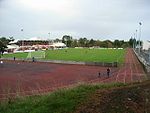Dafen, Carmarthenshire
Carmarthenshire geography stubsLlanelli RuralVillages in Carmarthenshire

Dafen is a village situated east of Llanelli in Carmarthenshire, Wales, part of the Llanelli Rural community. Dafen borders the villages of Felinfoel (Bryngwyn-Mawr), Bryn, Penceilogi, and Pemberton. Dafen is also an electoral ward, electing councillors to Llanelli Rural Council and Carmarthenshire County Council. At the 2001 census the Dafen ward had a population of 3,433, increasing to 3,597 at the 2011 Census.The village has both residential and industrial areas, and Llanelli's Prince Philip Hospital is located here. Wales Air Ambulance is based at Dafen in a purpose-built headquarters completed in 2016.
Excerpt from the Wikipedia article Dafen, Carmarthenshire (License: CC BY-SA 3.0, Authors, Images).Dafen, Carmarthenshire
Bryn Elli,
Geographical coordinates (GPS) Address Nearby Places Show on map
Geographical coordinates (GPS)
| Latitude | Longitude |
|---|---|
| N 51.692777777778 ° | E -4.1355555555556 ° |
Address
Prince Philip Hospital
Bryn Elli
SA14 8PW , Capel
Wales, United Kingdom
Open on Google Maps





